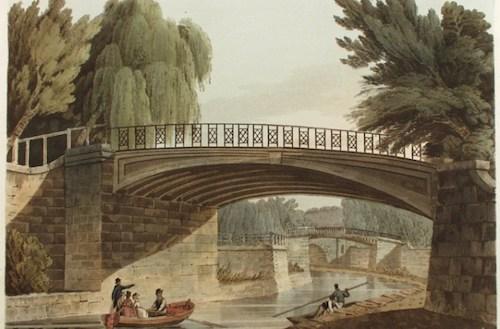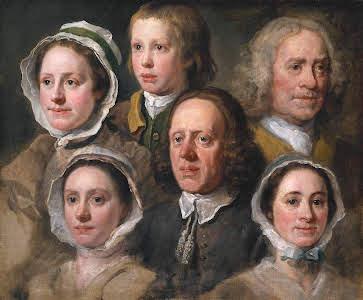Vauxhall Pleasure Gardens
 Vauxhall Gardens was a pleasure garden, one of the leading venues for public entertainment in London, from the mid 17th to mid 19th century. It was located in Kennington on the south bank of the River Thames, which was not part of the metropolis until towards the end of the Gardens' existence. Vauxhall Gardens was known as New Spring Gardens until 1785 and are believed to have opened just before the Restoration of the monarchy in 1660, on property formerly owned by Jane Fauxe, or Vaux, in 1615. Whereas John Nichols in his History of Lambeth Parish conjectures that she was the widow of Guy Fawkes, executed in 1606, John Timbs in his 1867 Curiosities of London states for a fact that there was no such connection, and that the Vaux name derives from one Falkes de Breauté, a mercenary working for King John who acquired the land by marriage.
Vauxhall Gardens was a pleasure garden, one of the leading venues for public entertainment in London, from the mid 17th to mid 19th century. It was located in Kennington on the south bank of the River Thames, which was not part of the metropolis until towards the end of the Gardens' existence. Vauxhall Gardens was known as New Spring Gardens until 1785 and are believed to have opened just before the Restoration of the monarchy in 1660, on property formerly owned by Jane Fauxe, or Vaux, in 1615. Whereas John Nichols in his History of Lambeth Parish conjectures that she was the widow of Guy Fawkes, executed in 1606, John Timbs in his 1867 Curiosities of London states for a fact that there was no such connection, and that the Vaux name derives from one Falkes de Breauté, a mercenary working for King John who acquired the land by marriage.
Vauxhall Gardens originally consisted of several acres laid out with walks. Initially, admission to the gardens was free and proprietors made money by selling food and drink. John Evelyn described "the New Spring Garden at Lambeth" as a "very pretty contrived plantation", in 1661. John Aubrey, in his Antiquities of Surrey gives us the following account:
At Vauxhall, Sir Samuel Morland built a fine room, anno 1667, the inside all of looking-glass, and fountains very pleasant to behold, which is much visited by strangers: it stands in the middle of the garden, covered with Cornish slate, on the point of which he placed a punchinello, very well carved, which held a dial, but the winds have demolished it.
The Spring Gardens were the most prominent vehicle in England for the public display of the new Rococo style. The earliest pictorial representation of Tyers' Spring Gardens, Vauxhall, is the "Vauxhall fan" (1736), an etching printed in blue designed to be pasted to a fan; it shows the earliest groups of pavilions, in a sober classical taste, but the interiors of the supper boxes were painted by members of Hogarth's St. Martin's Lane Academy, prominent among them Francis Hayman. Hayman provided most of the subjects, which were rapidly executed by students and assistants; Hubert Gravelot provided designs for two others, and Hogarth's designs were pressed into service in hastily dashed-off copies that filled the back of every box. At a certain hour, all the paintings were let down at once, to offer some security to the companies at supper and a suitable backdrop, one observer thought, for the live beauties of London.

The Vauxhall Fan (1736)
Frederick, Prince of Wales, who had come to England with his father George II in 1728 and who was a prominent patron of the Rococo, took sufficient interest in the Gardens to have his own pavilion built from the very first. The first fully Rococo structure erected at the Spring Gardens was the "Turkish Tent" that was still a novelty in 1744; "this fantastic structure introduced that element of frivolous impermanence which became so characteristic of Vauxhall," David Coke has remarked. In the course of the 1740s it was joined by other examples of Rococo chinoiserie and above all by the Rotunda, with the most-viewed Rococo interior decoration in England, designed by George Michael Moser, another member of the St. Martin's Lane Academy.

Interior of the Rotunda, (c. 1750s)
Popular with all classes of society, the Gardens were a noted venue for romantic assignations in the "dark walks". A footnote in a 2002 publication provides an unattributed and double-edged quote, noting that the gardens were "so intricate that the most experienced mothers often lost themselves in looking for their daughters". In 1732, their fashionable status was confirmed by a fancy dress ball attended by Frederick, Prince of Wales. At that time access from the West End was by water, but the opening of Westminster Bridge in the 1740s made access easier though less charming.  Enormous crowds could be accommodated at Spring Gardens, Vauxhall. In 1749 a rehearsal of Handel's Music for the Royal Fireworks attracted an audience of 12,000, and in 1786 a fancy dress jubilee to celebrate the proprietor's long ownership was thronged with 61,000 revellers. Many of the best known musicians and singers of the day performed at the Gardens, for example Sophia Baddeley. The main walks were lit at night by hundreds of lamps. Over time more features and eyecatchers were added: additional supper boxes, a music room, a Chinese pavilion, a gothic orchestra that accommodated fifty musicians, and ruins, arches, statues and a cascade. An admission charge was introduced from the beginning and later James Boswell wrote:
Enormous crowds could be accommodated at Spring Gardens, Vauxhall. In 1749 a rehearsal of Handel's Music for the Royal Fireworks attracted an audience of 12,000, and in 1786 a fancy dress jubilee to celebrate the proprietor's long ownership was thronged with 61,000 revellers. Many of the best known musicians and singers of the day performed at the Gardens, for example Sophia Baddeley. The main walks were lit at night by hundreds of lamps. Over time more features and eyecatchers were added: additional supper boxes, a music room, a Chinese pavilion, a gothic orchestra that accommodated fifty musicians, and ruins, arches, statues and a cascade. An admission charge was introduced from the beginning and later James Boswell wrote:
Vauxhall Gardens is peculiarly adapted to the taste of the English nation; there being a mixture of curious show, — gay exhibition, musick, vocal and instrumental, not too refined for the general ear; — for all of which only a shilling is paid.A great part of the entertainment was offered by the well-dressed company itself. Pauses between pieces of music were intentionally long enough to give the crowd time to circulate the Gardens anew. M. Grosely, in his Tour to London (1772) says, relating to Ranelagh Gardens and Vauxhall:
These entertainments, which begin in the month of May, are continued every night. They bring together persons of all ranks and conditions; and amongst these, a considerable number of females, whose charms want only that cheerful air, which is the flower and quintessence of beauty. These places serve equally as a rendezvous either for business or intrigue. They form, as it were, private coteries; there you see fathers and mothers, with their children, enjoying domestic happiness in the midst of public diversions. The English assert, that such entertainments as these can never subsist in France, on account of the levity of the people. Certain it is, that those of Vauxhall and Ranelagh, which are guarded only by outward decency, are conducted without tumult and disorder, which often disturb the public diversions of France. I do not know whether the English are gainers thereby; the joy which they seem in search of at those places does not beam through their countenances; they look as grave at Vauxhall and Ranelagh as at the Bank, at church, or a private club. All persons there seem to say, what a young English nobleman said to his governor, Am I as joyous as I should be?The new name Vauxhall Gardens, long in popular use, was made official in 1785. After Boswell's time the admission charge rose steadily: to two shillings in 1792, three-and-sixpence in the early 19th century, and 4/6 in the 1820s. Season tickets were also sold. Entertainment in this period included hot air balloon ascents, fireworks, and tightrope walkers. In 1813 there was a fête to celebrate victory at the Battle of Vittoria, and in 1827 the Battle of Waterloo was re-enacted by 1000 soldiers. The contributor to the Edinburgh Encyclopedia (1830 edition) comments that:
the garden's great attraction arises from their being splendidly illuminated at light with about 15,000 glass lamps. These being tastefully hung among the trees, which line the walks, produce an impression similar to that which is called up on reading some of the stories in the Arabian Nights Entertainments. On some occasions there have been upwards of 19,000 persons in them, and this immense concourse, most of whom are well dressed, seen in connection with the illuminated walks, add not a little to the brilliant and astonishing effect of the whole scene.Charles Dickens wrote of a daylight visit to Vauxhall gardens, inSketches by Boz, published in 1836:
We paid our shilling at the gate, and then we saw for the first time, that the entrance, if there had been any magic about it at all, was now decidedly disenchanted, being, in fact, nothing more nor less than a combination of very roughly-painted boards and sawdust. We glanced at the orchestra and supper-room as we hurried past—we just recognised them, and that was all. We bent our steps to the firework-ground; there, at least, we should not be disappointed. We reached it, and stood rooted to the spot with mortification and astonishment. That the Moorish tower—that wooden shed with a door in the centre, and daubs of crimson and yellow all round, like a gigantic watch-case! That the place where night after night we had beheld the undaunted Mr. Blackmore make his terrific ascent, surrounded by flames of fire, and peals of artillery, and where the white garments of Madame Somebody (we forget even her name now), who nobly devoted her life to the manufacture of fireworks, had so often been seen fluttering in the wind, as she called up a red, blue, or party-coloured light to illumine her temple!
Throughout its lifetime, Vauxhall Gardens passed through several hands. In 1840, the owners went bankrupt and the Gardens closed. They were revived the following year, and again in 1842. The Gardens were closed for what seemed like permanently in 1859, but as the land was redeveloped in the following decades and as a result of slum clearance in the late 20th century, part of the original site was opened up again. Charmingly, they called this reopened public park Spring Gardens as a nod to its original seventeenth century name, but renamed it in 2012 to its more well-known title, Vauxhall Pleasure Gardens.
Enjoyed this article? If you don't want to miss a beat when it comes to Jane Austen, make sure you are signed up to the Jane Austen newsletter for exclusive updates and discounts from our Online Gift Shop.




Leave a comment
This site is protected by hCaptcha and the hCaptcha Privacy Policy and Terms of Service apply.